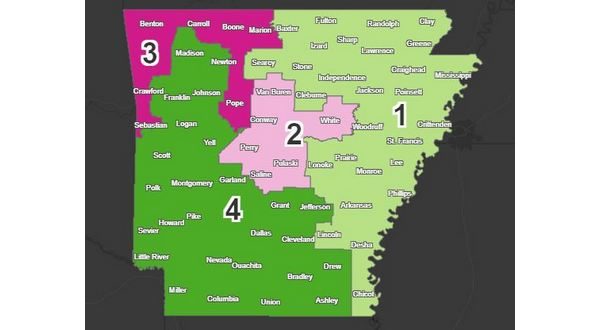
Maps and figures displayed Tuesday night at a public meeting organized by the Arkansas Board of Apportionment (ABA) show the Twin Lakes Area caught between exploding populations in northwest Arkansas and the Little Rock metro area and cratering populations in the Delta and southern Arkansas.
The ABA consists of the governor, attorney general and secretary of state and is charged with redrawing the district maps for the state’s House of Representatives and Senate. The redrawing is a once-a-decade process tied to population numbers collected by the U.S. Census.
Tuesday night’s meeting at the Vada Sheid Community Development Center was the second of eight public meetings scheduled around the state to answer public questions about the process and solicit public comments from the community. The meeting was attended by about 50 people, including state Rep. Jack Fortner of Yellville, several Baxter County elected officials and at least three area mayors.
The series of public meetings launched Thursday night in Monticello before traveling north to Mountain Home Tuesday night. Former state Supreme Court Justice Betty Dickey serves as the ABA’s redistricting coordinator, and talks about the first meeting in Monticello.
Listen:
Under the state’s constitution, Arkansas is required to have 100 seats in its House of Representatives and 35 seats in its Senate. State law requires that the legislative districts be “substantially equal,” meaning that each district be within 5% of one another based on total population. Dickey said using current U.S. Census population estimates, that means each House district should hold about 30,000 residents and each Senate district should count about 85,000 residents.
All of the figures and maps displayed Tuesday night used 2019 population estimates. The actual redistricting plans will use figures from the 2020 U.S. Census, but those numbers are not yet available and will not be released until the fall.
Based on the 2019 estimates, the districts of all Twin Lakes Area state legislators are under represented slightly, meaning they currently hold less than the targeted average population of each district, but most appeared to remain inside the 5% plus/minus leeway allowed under state law.
A district below the average could possibly grow to even its numbers up to the average, while a district with too many residents would see its borders shrink and the excess population assigned to another, less-populated district.
In the Senate, Scott Flippo’s District 17 was estimated to be down 1,096 residents compared to the average, which would be a shortfall of 1.3%. Missy Ivin’s District 18 was estimated to have 4,745 fewer people than the average district, which would place her district at 5.5% below the average.
In the House, Michelle Gray’s District 62 was estimated to be down 523 people compared to the average, which would be a shortfall of 1.7%. John Payton’s District 64 was estimated to have 1,856 fewer people than the average district, a decline of 6.2% compared to the average. Jack Fortner’s District 99 was estimated to be down 430 compared to the average, which would be a shortfall of 1.4%. Nelda Speaks’ District 100 was estimated to have 906 fewer people than the average district, which would place her district at 3% below the average.
Districts in northwest Arkansas and the Little Rock area have ballooned over the past decade, with some districts estimated at having added tens of thousands of residents.
Sen. Bart Hester’s District 1, which includes parts of Bentonville, is estimated to have a population of 113,508, which is almost 28,000 people above the targeted average for each district. Sen. Kim Hammer’s District 33, which includes Bryant and parts of Saline County, is estimated to hold 100,109 residents, which would be 14,400 more residents than allowed.
The opposite was seen in southeast Arkansas, with some of those districts estimated at being below the targeted average by 10,000 residents or more.
Sen. Stephanie Flowers’ District 25, which includes Pine Bluff, is estimated to have 72,985 residents, and would need an additional 12,700 residents to average it out with other districts. Sen. David Wallace’s District 22, which includes the area southeast of Jonesboro in rural Craighead, Poinsett and Mississippi counties, is estimated to need an additional 10,800 residents to bring it in line with the average.
Dickey likens the redistricting process to assembling a jigsaw puzzle with adjustable pieces. She says adjusting the boundaries of an overpopulated district has a domino effect on other districts.
Listen:
During the public comment portion of Tuesday’s meeting, one attendee asked that the ABA consider a Senate district consisting of Boone, Carroll, Newton, Searcy and part of Newton County. That area shares much in common, like the Buffalo National River. That area is currently served by four different state senators.
Another attendee requested the Jordan community be included in legislative districts that include Mountain Home and Baxter County. Her currently state representative is Payton, who lives about 75 miles away in Wilburn.
Twin Lakes Area residents may submit redistricting comments and suggestions by visiting arkansasredistricting.org and clicking on the “Public Comments” tab. The ongoing series of public meetings about redistricting will be held on the evenings of Tuesdays and Thursday throughout the month and can be seen live on Arkansas PBS.
The ABA must complete its work by the end of the year, but faces a time crunch since the release of official figures from the U.S. Census has been delayed about six months and will not be released until late September. Once the raw data is released, it must be converted into a format the ABA can interpret. Once the revised district maps are completed, the ABA must wait 30 days for public comment before the new maps can be finalized.
WebReadyTM Powered by WireReady® NSI










